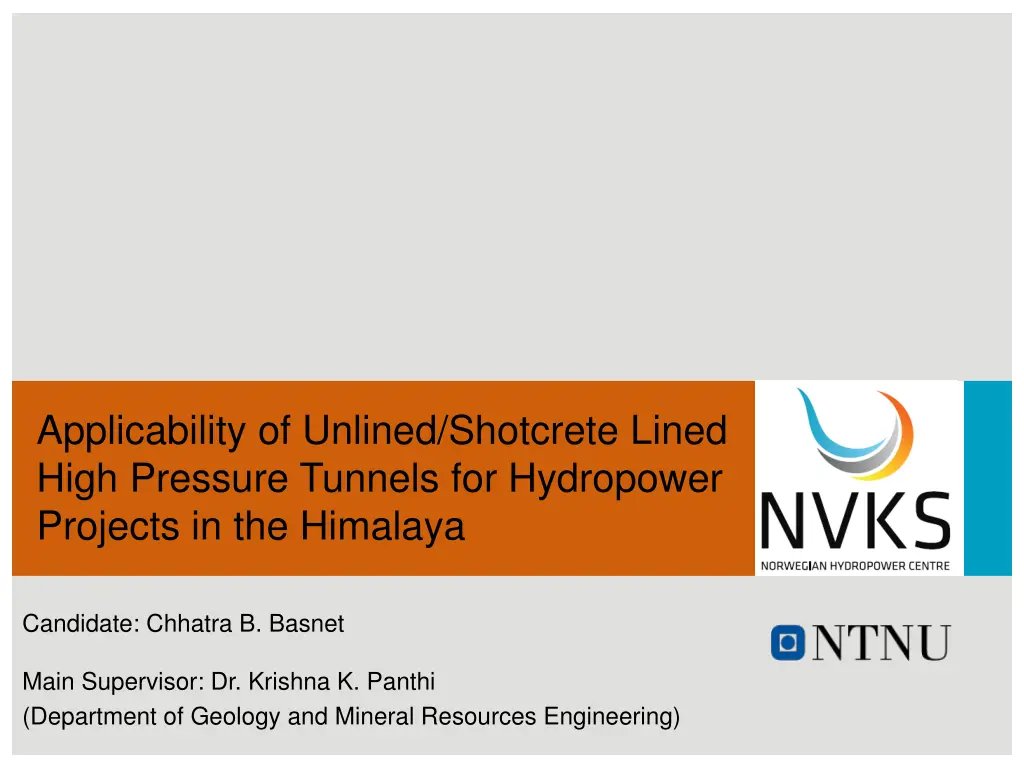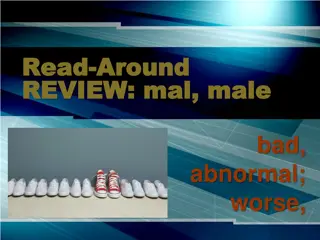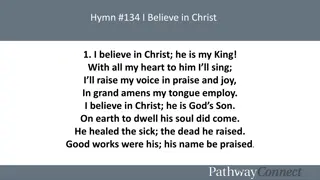
Unlined and Shotcrete-Lined High Pressure Tunnels for Hydropower Projects in the Himalaya
Explore the applicability of unlined and shotcrete-lined high pressure tunnels for hydropower projects in the Himalaya region. Delve into the major issues, research questions, and cases that have influenced this concept, highlighting the importance of hydraulic criteria and long-term stability.
Download Presentation

Please find below an Image/Link to download the presentation.
The content on the website is provided AS IS for your information and personal use only. It may not be sold, licensed, or shared on other websites without obtaining consent from the author. If you encounter any issues during the download, it is possible that the publisher has removed the file from their server.
You are allowed to download the files provided on this website for personal or commercial use, subject to the condition that they are used lawfully. All files are the property of their respective owners.
The content on the website is provided AS IS for your information and personal use only. It may not be sold, licensed, or shared on other websites without obtaining consent from the author.
E N D
Presentation Transcript
Applicability of Unlined/Shotcrete Lined High Pressure Tunnels for Hydropower Projects in the Himalaya Candidate: Chhatra B. Basnet Main Supervisor: Dr. Krishna K. Panthi (Department of Geology and Mineral Resources Engineering)
Contents Norwegian unlined pressure shaft / tunnel concept Research question of the PhD work Major issues for unlined shafts / tunnels Applicability in the Himalayan environment Conclusions
Norwegian unlined shaft / tunnel concept 3 Surge Shaft Surge Chamber Adit 1 Adit Headrace Tunnel Unlined Unlined a. Before 1930 Shaft b. From 1955 to date Shaft Powerhouse Access Steel Lining Steel Lining Tailrace Tunnel Powerhouse Adit Unlined Surge shaft (Alternative to AC) Shaft Adit c. From 1960 to date d. From 1970 to date Air Cushion chamber (AC) Steel Lining Unlined Tunnel Unlined High - pressure Tunnel Steel Lining
Cases that helped to build and upgrade the concept Cross-section Area (m2) 8.0 (Tunnel) Tunnel 4.5 (Shaft) 6.0 (Shaft) 9.0 (Tunnel) 10.0 (Tunnel) 18.0 (Tunnel) Project Year Water head (m) Rock types Failure condition Herlandsfoss Skar Svelgen Byrte sk ra Bjerka Holsbru 1919 1920 1921 1968 1970 1971 2012 136 129 152 303 210 72 63 Mica-schist Gneiss-granite Sandstone Granite Gneiss Devonian Sandstone Gneiss Dark Gneiss Partly failed Completely failed Minor leakage Partly failed Partly failed Partly failed Leakage
The principle requirement 3 1 ?3> ??
Research question of the PhD work What could be the requirement that helps to use unlined / shotcrete lined pressure shafts and tunnels in the Himalaya?
Major issues for unlined shaft / Tunnels Hydraulic criteria Hydraulic spliting Long term stability of the waterway
Hydraulic Criteria Rough tunnels will have higher roughness and higher headloss Unlined tunnels are rougher than lined one Trade off between the extra headloss due to rough surface and cost of lining Optimization Optimized roughness depends upon energy price and cost of construction Field work completed and analysis underway
Hydraulic splitting Fracture initiation in rockmass or opening of existing fractures In-situ (field) test is necessary to build the criterion 3 1
Field test Pw Data logger Tightening Handle Tunnel wall Reducer 1" 4 1 1" 4 1 1" 1/2" 15 Drill hole (75mm dia.) Valve Pipe Valve Pressure gauge Reducer Flowmeter Packer Inner pipe 1/2" Outer pipe Test section Pump, Pipe Up to 50 bars Water Source
Field test Flow Meter Pressure Gauge 0-40 Bars 0-60 Bars Inner and outer pipes
Test output Idealized hydraulic fracturing pressure record (ISRM, 1987*) * Suggested methods for rock stress determination
Long term stability of tunnel Stress induced instability (rock spalling, rock burst etc) Rock mass should be strong enough to sustain the insitu stress Rock mass strength to be determined
Rock mechanical properties State-of-art Triaxial Press installed at IGB (NTNU) laboratory in 2013 (Photo: Basnet, C.B.) Cores, extracted from the samples collected from field and ready for UCS Test
Numerial modeling Modelling of hydraulic splitting phenomenon in the rock mass around pressure tunnel Use of FLAC3D/3DEC Stability analysis
Conclusions Headloss measurement has been carried out in the field and roughness of shotcrete lined tunnels is back calculated Field test arrangement for hydraulic splitting is underway This field test is simple and easy to use (Hope). Once it is applied in this research work, it can be implemented and used later on Unlined pressure shafts and tunnels are the economical solution in hydropower projects





















